| Arches National Park was one of the places which was high on our
list of places we had to visit. It did live up to expectations. It is the
largest collection of natural arches in the world and over 2,000 have been
catalogued although only about 20 are shown on the visitors' map. We
actually visited it twice. There is a road into the park with branches on
it. Unfortunately the scooter did not have the range to do all the branches
on one trip, and secondly with temperatures over 100°F
we couldn't cope either. | 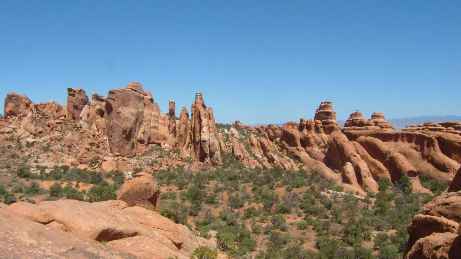 |
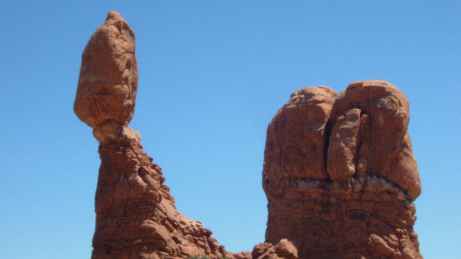 |
The park entrance is just north of Moab and our National Parks pass again
showed its worth. There is a fairly steep climb to 5000ft and then a twenty
mile drive to where most of the arches are actually found. The formation on
the right is called "Balanced Rock" and is one of the first
features to be
encountered. The arches are formed when the lower sandstone is worn away
before the higher levels. This occurs because there are several layers of
sediments deposited here and the later ones are harder. Often the sandstone
weathers into fins as shown above and it is in these fins that the arches
appear. |
| At the end of the drive is a walk of about 3 miles (each
way)which is partly flat and paved and gets progressively more difficult
(becoming almost downright impossible unless you are in to rock climbing!) This is one of the more accessible arches
called "Landscape Arch". It also has the longest span. They have a photo taken
by a visitor of a 160 ton chunk of rock falling from the right hand
(thinnest) side -
evidence of continuing erosion. Now you cannot approach any nearer than
this. | 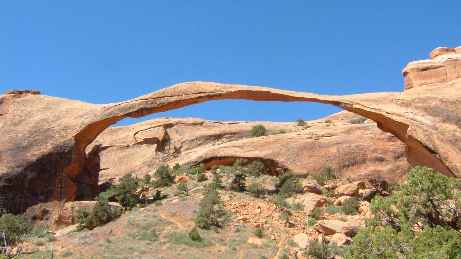 |
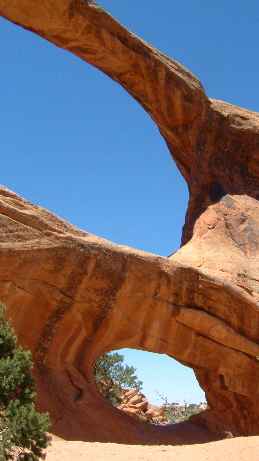 |
At the end of the walk is the spectacular "Double-O" arch. Getting to this
involves walking along one of the sandstone rock fins seen in the first
picture. In many ways these are very difficult structures to photograph
because you cannot get far enough away without losing sight of them
altogether in the twists and turns of the path. A black cryptobiotic crust exists
on many areas off the pathway which is part of the delicate ecological
balance of nature here. A footprint can destroy 1000 years of growth of
microscopic organisms. What
was remarkable was the amount of animal life present in the form of small
rodents and lizards. We sat and watched some while we rested before the
journey back, but they were too quick to photograph. |
| This was one of the other arches on a side track. This is "Tunnel
Arch" and gave views away to the south over miles of barren rocky lands as
far as the eye can see. You are advised to take plenty of water with you on
the walk and by now we were beginning to realise that we had not brought
enough and getting back to the parking space and another bottle was going to
use all our remaining energy. | 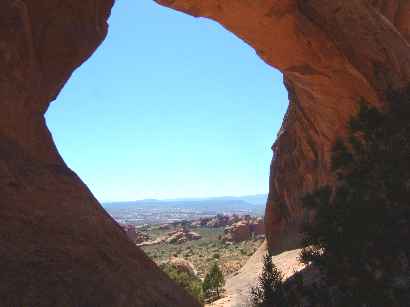 |
 |
The road back towards the park entrance crosses several valleys and some of
the views such as this one are very spectacular. If you look carefully you
can just see the road passing from left to right about halfway down the
picture and then back again in the bottom left hand corner. Closer to us it
traverses again before climbing the ridge we were on and moving from right to
left. The scale of these works of nature is just immense. |
| We did go back again to visit another leg off the main road. This
led to the Windows collection. This was "Double Arch" but there are two
separate windows "North" and "South" which can also be viewed as the
"Spectacles". | 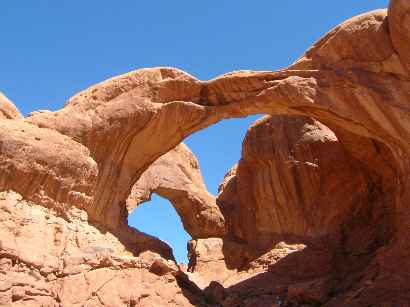 |
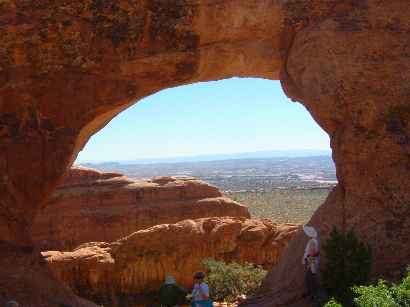 | This
last shot is (I think) of the "North Window" and again shows the view away
into the distance. |
We had planned to visit Canyonlands National Park whilst we were in Moab but
whilst unloading the scooter I wrenched my back and was in some pain. Even a
brief visit would have entailed 30 miles each way in a four wheel drive vehicle
on rough tracks. We decided that I couldn't cope because of my back and Jan
couldn't cope because of the heat so we abandoned it this time. The locals told
us that the temperatures the week before had been below normal for the time of
year but our week temperatures soared to 20°F above
normal. It seems that things can flip from one extreme to the other very quickly
here. |